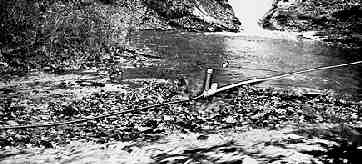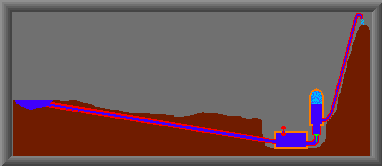
A
WORD FROM RBO's EDITOR:
We are pleased to have
many visitors from around
the world on this page.
Please, feel free to
download the audio-file
and to use it cost-free.
However, this will be
under the condition that
you inform RBO about
intended use by sending a
mail to: radiobridge@aol.com
Any other feedback would
also be appreciated.
The copyright remains
with RBO. |
"MAKING
IT WORK"

IN ZIMBABWE - EPISODE A

These
girls live in the Eastern
mountains of Zimbabwe
with lovely green hills
and sparkling cool
streams. Yes, the Eastern
highlands of Zimbabwe
have plenty of water
flowing along the
mountains. The charming
Nyachohwa Falls, on the
previous page, tumbling
into a natural woodland
pool, always come as a
delightful surprise to
tourists.
But
these girls have to carry
water every day to the
top of the mountain where
their village nestles.
Their problem is to
capture this water and
bring it into their
homesteads where they can
use it for bathing,
drinking, cooking and for
watering their gardens.
These girls have one
dream:

We take a look at the
problem many communities
are facing with trying to
get water, and at one
solution which seems to
be working in Zimbabwe,
thanks to a flow of
information which
connects people in North
and South through
centuries.

This is the almost
invisible solution - the
system of the RAM PUMP
It works on the same
principles of physics
that enable its
cumbersome predecessors
to water the farmlands of
Europe, the MidEast and
Asia over the past two
hundred years. John
Whitehurst is credited
with inventing a
non-self-acting ram pump
in England in 1772. By
1796 a Frenchman, Joseph
Michael Montgolfier, had
added a valve, which made
the device self-acting,
making the ram pump
almost a perpetual motion
machine when water
supplies were steady. In
1809, the first American
patent was issued to J.
Cerneau and S.S. Hallet
in New York...but it
wasn't until 1832 that
information began
spreading across the
eastern states about the
"simple pump that
pushes water uphill using
energy from falling
water." Water-hungry
rural Americans were
intrigued by the pumps.
Benson's Patent Water Ram
could pump water from the
powering stream or spring
up a hill or it could use
that power to push
another water
supply....potable
perhaps...uphill.
Articles in magazines
such as the Farmer's
Cabinet and American
Farmer brought further
recognition and
understanding of the ram
and its possibilities.

For more than 100 years
rams were major movers of
water to homes, farms,
industries, railroads and
towns. They contributed
to improved crop
production, introduction
of extensive landscaping
and gardening, and,
perhaps most importantly,
to health and sanitation.
But with the advent of
electrical pumps,
interest in the hydraulic
rams became dormant. Ram
pumps were allowed to
rust in the stream until
expensive parts, fossil
fuel shortages, and
environmental concerns
brought back to the
public's mind the need
for a pump that is
inexpensive, requires
almost no repairs or
maintenance, is
self-acting, and which
can raise water to a
considerable height
vertically. The public
began searching for a ram
it could readily afford,
pick up easily and move
if necessary.

Ram Pumps only have two
moving parts, making them
virtually
maintenance-free. Water
enters the lower of two
chambers through a pipe
from an elevated water
source. This pipe must be
relatively long and thick
so that significant force
(inertia) is developed as
the water moves down it
to the chamber. As water
rushes in it starts the
pump. The chamber fills
and the ESCAPE VALVE
shuts. The DELIVERY VALVE
to the AIR DOME opens.
The momentum of the
rushing water pushes some
water into the air dome
and compresses the air
that partially fills that
chamber. When the
pressure is great enough
it opposes the force of
the incoming water and
the second valve drops
shut. After the delivery
valve shuts, air pressure
pushes water up the
outlet pipe. In the first
chamber, all valves are
closed and no water can
move, so the escape valve
drops open and the cycle
begins to repeat, about
once a second. This is an
ideal pump when a
plentiful water source is
available. Roughly 3/4's
of the water that passes
through the system exits
via the escape valve.
Get more information
about operational
requirements from:

GEORGE
MSUMBA OF RBO

REPORTING
FROM ZIMBABWE
"How
to harness water in a
cheap way"
14'17" / LISTEN

You can go
back to the introduction
page by hitting the
button above.

You can go to the next
episode by hitting this
button,
or you access episodes of
your choice by clicking
on one of the thumbnails
below.


|